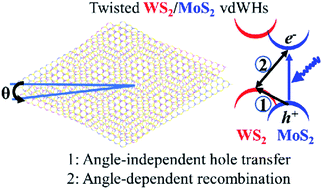The twist angle has weak influence on charge separation and strong influence on recombination in the MoS2/WS2 bilayer: ab initio quantum dynamics†
Abstract
Van der Waals heterojunctions of two-dimensional transition-metal dichalcogenides are intensely investigated for multiple optoelectronics applications. Strong and adjustable interactions between layers can influence the charge and energy flow that govern material performance. We report ab initio quantum molecular dynamics investigation of the influence of the bilayer twist angle on charge transfer and recombination in MoS2/WS2 heterojunctions, including high-symmetry 0° and 60° configurations, and low symmetry 9.43° and 50.57° structures with Moiré patterns. The twist angle modulates interlayer coupling, as evidenced by changes in the interlayer distance, electron-vibrational interactions, and spectral shifts in the out-of-plane vibrational frequencies. Occurring on a femtosecond timescale, the hole transfer depends weakly on the twist angle and is ultrafast due to high density of acceptor states and large nonadiabatic coupling. In contrast, the electron–hole recombination takes nanoseconds and varies by an order of magnitude depending on the twist angle. The recombination is slow because it occurs across a large energy gap. It depends on the twist angle because the nonadiabatic coupling is sensitive to the interlayer distance and overlap of electron and hole wavefunctions. The Moiré pattern systems exhibit weaker interlayer interaction, generating longer-lived charges. Both charge separation and recombination are driven by out-of-plane vibrational motions. The simulations rationalize the experimental results on the influence of the bilayer twist angle on the charge separation and recombination. The atomistic insights provide theoretical guidance for design of high-performance optoelectronic devices based on 2D van der Waals heterostructures.



 Please wait while we load your content...
Please wait while we load your content...